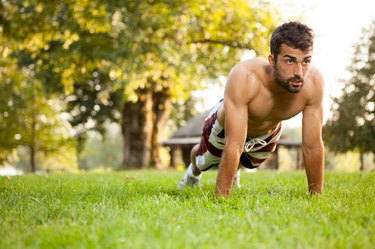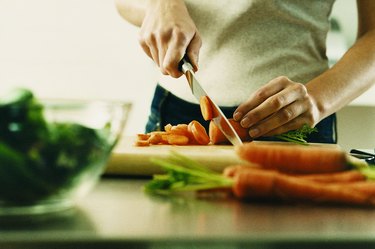
Participating in a consistent diet and exercise regimen will help to burn fat and build muscle. However, according to West Virginia University, fat and muscle are composed of completely different cells making conversion impossible. When you consume more calories than you burn your body stores those calories as fat, increasing the size of your fat cells. When you "burn fat" you are actually decreasing the size of your fat cells. Similarly, building muscle is simply increasing the size of your muscle cells. Strength training, aerobic exercise, and a healthy diet help burn body fat and build muscle.
Losing Body Fat and Building Muscle
Video of the Day
Step 1

Participate in 30 minutes of aerobic exercise per day. According to Dukehealth.org, aerobic exercise is the most effective form of exercise for burning fat. Running, swimming, and biking are all forms of aerobic exercise. How long it will take you to burn excess body fat depends on your consistency and workout intensity level. According to the American Exercise Council a healthy rate of fat loss is one to two pounds per week.
Video of the Day
Step 2

Dedicate at least two days a week to muscle-building exercises. The Centers for Disease Control and Prevention recommend two or more days a week strengthening major muscle groups such as legs, hips, back, abdomen, chest, shoulders, and arms. Complete three sets of eight to 12 repetitions for each resistance or weight training exercise. Focus on proper form and completing the full range of motion for each repetition. Progressively increase weight as you become stronger.
Step 3

Eat a cleaner, healthier diet. There are 3,500 calories in a pound of fat. Burning 500 calories per day more than the amount of calories you consume equates to one pound of fat loss per week. The University of Alabama recommends counting calories to make sure you consume the correct amount of calories per day. Consuming too little can lead your body to conserve fat and burning muscle for energy; consuming too much converts excess calories into fat. Installing a calorie-counting app on your phone or computer can help to keep you on track. A clean diet consists of lean meat, whole grains, fruits and vegetables. Avoid processed foods, butter, and sugary drinks.
Things You'll Need
Weights, resistance bands, or medicine balls
Gym membership (Optional)
Tip
Working out with a buddy, or hiring a personal trainer, can help to keep you motivated and on track to reaching your goals
Warning
Consult with your physician before beginning any type of diet and exercise regimen.
- West Virginia University: WELL WVU: 10 Dieting Myths
- Centers of Disease Control and Prevention: How much physical activity do adults need?
- Columbia Health: Go Ask Alice
- University of Alabama: Clean Eating & Exercise Plan
- The American Council on Exercise: What are the guidelines for percentage of body fat loss?